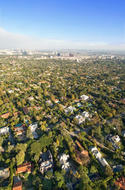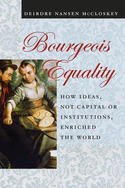The consumer technology boom, largely responsible for a resurgence in California’s economy after the tech wreck of 2001, seems to be coming to an end. The signs are widespread: slowing employment, layoffs from bell-weather social media companies, the almost embarrassing difficulty of finding buyers for Twitter, the absorption of Yahoo by Verizon and the acquisition by Microsoft of LinkedIn. read more »
Can California Transition to Next Tech Wave?
- Login to post comments
Trump Will Go Away, but the Anger He’s Stirred Up Is Just Getting Started
For progressives, the gloating is about to begin. The Washington Monthly proclaims that we are on the cusp of a “second progressive era,” where the technocratic “new class” overcomes a Republican Party reduced to “know-nothing madness.”
To be sure, Trump himself proved a mean-spirited and ultimately ineffective political vessel. But the forces that he aroused will outlive him and could get stronger in the future. In this respect Trump may reprise the role played another intemperate figure, the late Senator Barry Goldwater. read more »
Unsustainable solutions in the name of sustainability
The other day when I was riding my bike in Minneapolis crossing I-94 near Riverside I encountered a small townhome project built during the first (failed) green era under the Carter administration. It was built to showcase the future. One thing I've learned over the years building my own green homes is to not listen blindly to the experts who parrot others' ideas without thinking of the ramifications.
The world's first solar and earth-berm grass-roof townhome projects look like this today: read more »
- Login to post comments
The House Prices are Too Damned High
In recent years, the plight of renters in a stagnant economy has been covered extensively. A book title incorporated the phrase “the rent is too damn high” (by Matthew Iglesias). The “Rent is Too Damn High Party” ran candidates in both city and state of New York elections. However, as bad as rent increases have been, more serious has been the escalation of house prices in the major metropolitan areas of the United States. read more »
- Login to post comments
A Capital Improvement and Revitalization Idea for Detroit
You may have heard that Detroit is in the midst of a modest but enduring revival in and around its downtown. Residents and businesses are returning to the city, filling long-vacant skyscrapers, prompting new commercial development and revitalizing adjacent old neighborhoods. As a former Detroiter I'm excited to see the turnaround. After so many false starts, Detroit's post-bankruptcy rebound seems very real. read more »
- Login to post comments
Today’s Orange County: Not Right Wing—and Kinda Hip
What comes to mind when you think about Orange County? Probably, images of lascivious housewives and blonde surfers. And certainly, at least if you know your political history, crazed right-wing activists, riding around with anti-UN slogans on their bumpers in this county that served as a crucial birthplace of modern movement conservatism in the 1950s. read more »
Two Cheers for NIMBYism
Politicians, housing advocates, planners and developers often blame the NIMBY — “not in my backyard” — lobby for the state’s housing crisis. And it’s true that some locals overreact with unrealistic growth limits that cut off any new housing supply and have blocked reasonable ways to boost supply.
But the biggest impediment to solving our housing crisis lies not principally with neighbors protecting their local neighborhoods, but rather with central governments determined to limit, and make ever more expensive, single-family housing. Economist Issi Romem notes that, based on the past, “failing to expand cities [to allow sprawl] will come at a cost” to the housing market. read more »
- Login to post comments
Diedre McCloskey’s Trickle-Out Economics
Economics, history, English and communications Professor Diedre N. McCloskey, of the University of Illinois, Chicago offers a unique interpretation of economic history that is well summarized in the subtitle of her book, “Bourgeois Equality: How Ideas, Not Capital or Institutions Enriched the World.”
This is a magisterial volume, which Matthew Ridley praised in his Times of London review, saying “It is so rich in vocabulary, allusion and fact as to be a contender for the great book of our age.” That is not an exaggeration. read more »
- Login to post comments
America's Next Great Metropolis Is Taking Shape In Texas
If you drive south from Dallas, or west from Houston, a subtle shift takes place. The monotonous, flat prairie that dominates much of Texas gives way to a landscape that rises and ebbs. read more »
- Login to post comments
The New War Between the States
In this disgusting election, dominated by the personal and the petty, the importance of the nation’s economic geography has been widely ignored. Yet if you look at the Electoral College map, the correlation between politics and economics is quite stark, with one economy tilting decisively toward Trump and more generally to Republicans, the other toward Hillary Clinton and her Democratic allies. read more »
- Login to post comments





















